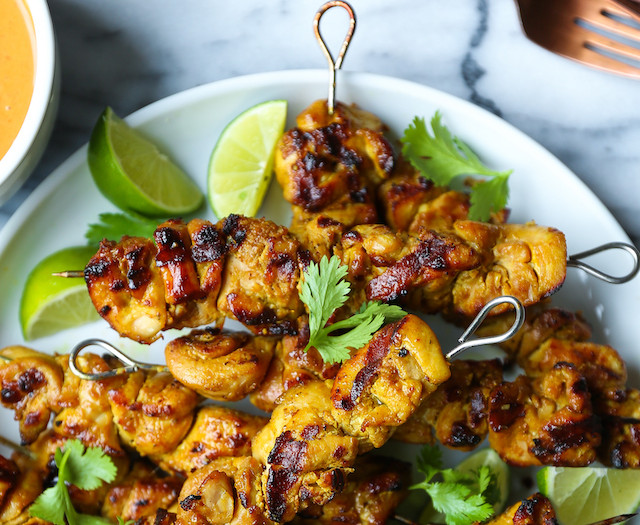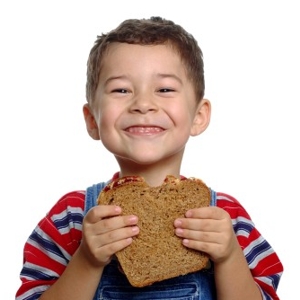It’s time to set the story straight on Peanut Butter. There are as many myths circulating about this ubiquitous pop-spread as there are valid observations. And it may surprise you to discover that the positives outweigh the negatives!
 Savoury skewers marinated in, basted with and dipped in spicy, peanutty Satay sauce.
Savoury skewers marinated in, basted with and dipped in spicy, peanutty Satay sauce.
A Southeast Asian staple as famous in its context as Peanut Soup in West Africa…
Just two of the legendary dishes made all over the world with peanut butter.
There’s a reason the kid in the picture at the top of this post has a big smile on his face. Not only has peanut butter been rehabilitated in general as a valuable source of essential nutrients. It’s also been declared less of a ‘threat’ to those who are allergic, thanks to recent discoveries in desensitization treatment.
A unique phenomenon
Peanut Butter is a unique culinary phenomenon. The US National Peanut Board reports that 94 percent of American homes have at least one jar of peanut butter in their pantries. And the average American eats around three pounds of peanut butter each year. It’s also one of a very few, rare foods that can be used in almost all imaginable ways. People around the world cook with it and bake with it, and eat it as a topping, a filling or a spread on sandwiches. It’s as versatile in savoury roles as it is in sweet dishes!
The State of the Spread
Nutrition Profile
When you visit the official US Food and Drug Administration (USDA) nutrition facts page for Peanut Butter, you are confronted with a bewildering list. The USDA runs down every last microscopic component of the stuff. But it can be boiled down to a short list that both confirms some of our common knowledge about PB and holds some surprises…
One 2 tbsp. / 30 g serving of PB delivers:
- 191 Calories
- 7.1 g protein
- 16.4 g total fat
- 7.4 g carbs
- 1.7 g fibre
- 3.36 g total sugars
… Plus the following essential vitamins and minerals:
- 15.7 mg calcium
- 53.8 mg magnesium
- 1o7 mg phosphorus
- 179 mg potassium
There are also small but significant amounts of vitamin E, several B vitamins, choline and folate.
Fat content
Folks often point to PB as a high-fat food. And, therefore, unhealthy. But the truth is, the majority of its fats are monosaturated and polyunstaturated. And that’s a good thing.
Allergies
Major strides have been taken in recent years toward understanding and treating peanut-related allergies. Medical authorities are now recommending desensitization therapy for young children who show peanut sensitivities. Alas, older kids (school age and up) do not respond as well as infants and pre-schoolers. Nevertheless, peanuts – in particular PB – are no longer universaly demonized. Progressive school board are even easing their anti-peanut rules in line with current ‘common sense’ guidelines.
Origin options
How healthy your peanut butter is depends greatly on where it comes from. Most folks will just go to the grocery store and grab a jar. But commercial PB is often over-salted and dosed with cheaper non-peanut oils and fats to impart its consistent smooth texture. It may also be further processed to ensure that the oil doesn’t separate from the solids as the product sits on the shelf. And, of course, it may also contain the usual preservatives and other additives that processed foods are prey to.
Don’t be fooled by the label on commercial organic PBs. They simply use peanuts that were raised organically. But they may also contain the same additives, and undergo the same processing that regular commercial products do.
The peanut butter you get at your neighbourhood ‘health food’ store may be ‘only peanuts’ – with low or no salt, and no additives. But it will separate. My experience is, you’ll have to stir it every time before you spoon out a serving. But it will fulfill its stated promises. You might want to check and see what kind of oil or fat the bulk stuff contains. It should be 100 percent peanut oil. That’s one big reason you’ll pay a hefty premium for the ‘health food’ store product.
Of course… If you can commit a little time and energy to the project, you can make your own PB in a couple of quick, simple steps. Get roasted, unsalted peanuts at the bulk store. Choose ‘red skinned’ nuts for a bolder,’ peanuttier’ flavour. Splurge on a small bottle of peanut oil if you want to keep it authentic and ‘on the healthier side’ re.- the fats.
Use your smoothie/bar blender or food processor to crush – come purée – the nuts and add oil a little at a time until you achieve the desired consistency. You have the luxury of totally controlling the amount of salt you add. You really must add some salt – or else the product will taste pasty and starchy, rather than smooth and creamy. You may also want to consider adding a little sweetener. I recommend honey – for a flavour marriage made in heaven!
My take
A nouveau-superfood!
I agree with doctors and nutritionists who are now praising Peanut Butter as a nouveau-superfood. It’s naturally cholesterol free and high in antioxidants and polyphenols. And though it is admittedly high in calories, it’s less fattening by far than most junk foods.
Markita Lewis, a registered dietitian and Marketing & Communications Associate for the National Peanut Board, says, “A serving of peanut butter is nutrient-dense and contains good fats, 7 grams of protein and 2 grams of fiber, which make it a satisfying food that can help maintain a healthy weight or weight loss.”
“Peanut butter is also a good source of heart-healthy monosaturated fats, which can help lower LDL (harmful) [fats, leading to lower] cholesterol and triglyceride levels,” notes Registered Dietician Wan Na Chun, principal of One Point Wellness.
DO make your own!
It’s so easy to make your own PB that any mom or dad who really wants their kids to have the best will not think twice about it. And you can experiment with different types of peanuts and blends to achieve the optimum flavour you prefer.
As for cost… Making your own PB can reflect significant savings – if you source your peanuts carefully. You can do a lot better than that, cost wise and health-wise, by making your own. Today, a 1 kg jar of name-brand PB is priced at $7.99. / $6.50 each, if you buy 2 or more. 1 kg of roasted, unsalted peanuts at Bulk Mart is going for as little as $5.25 …
~ Maggie J.

